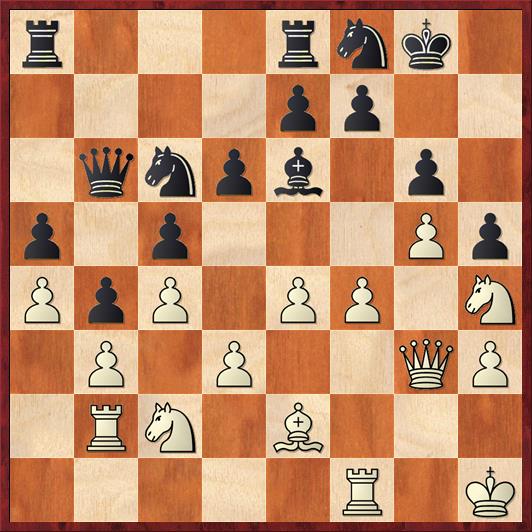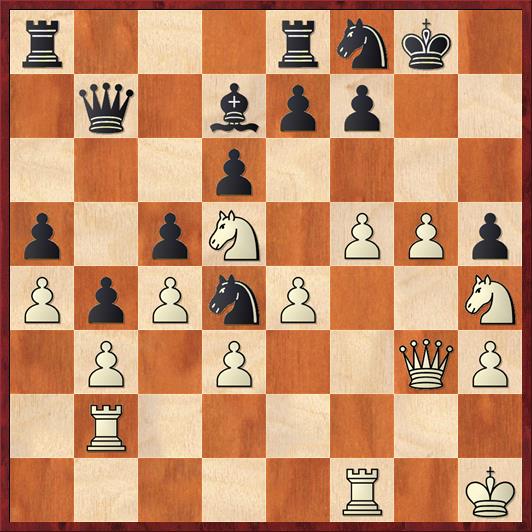Who do you think is better in this position? What is White’s plan, and what should he do next move?
Position after 25. … Nf8. White to move.
FEN: r3rnk1/4pp2/1qnpb1p1/p1p3Pp/PpP1PP1N/1P1P2QP/1RN1B3/5R1K w – – 0 26
In this game I was playing White against Shredder, the computer, set at a 2050 rating. It had thrashed around without a plan for several moves, and I felt that I must have an advantage, because it has foolishly allowed the queenside, where it had a space advantage, to become locked up. Not only that, it has traded its fianchettoed king bishop, weakening its kingside considerably. Moreover, the kingside is still very fluid, with the pawn break f4-f5 in the air. I would go so far as to say that White’s game is positionally won.
Here I took a time-out, because I wanted to study whether 26. Bxh5!? was possible. (As most readers know, I like to allow myself one time-out per game when playing the computer.) So that was, of course, the first move that I looked at. It’s very tempting. One possibility is 26. Bxh5 gh 27. f5 Bd7 28. g6. But here I was not able to convince myself that I had a win — and that’s a serious problem if I have invested a piece sacrifice in my attack. Another thing that stopped me was that Black has various ways of returning the piece sacrifice. Although White should be doing well if that happens, is this really the best way for White to play? And finally, I thought that in lines like 26. Bxh5 gh 27. f5 Bd7 28. Ne3, Black gets to play 28. … Ne5, and the knight on this square is quite a good defender.
The conclusion I came to is that White is sacrificing a piece too soon, before he has brought up all of his forces. The knight on c2, especially, really wants to join in the attack. In addition, White is playing f4-f5 too soon, which makes life easier for Black in some ways because he gains the square e5 for his knight. Instead, White should improve his position as much as possible before making that square available. It’s all a matter of timing.
Finally, I realized that there are absolutely no negative consequences to playing 26. Ne3! Black is completely tied up, with no aggressive possibilities and no moves that could materially change the position. If I want to, I can sac the bishop on h5 next move… or the move after that… or whenever I feel like it.
There is only one move that could change White’s plan of Ne3, f5, Nd5, and Bxh5. That is for Black to play 26. … Nd4, possibly planning to remove the bishop from the board so it can’t sac itself on h5. But gradually I realized that this is exactly what White wants to happen! Black’s knight defends better on e5 than on d4; on d4 it will turn out to be misplaced and irrelevant. So by playing 26. Ne3 and waiting for Black to declare his intentions, he gives Black the rope with which to hang himself. Or, to go along with the concept of timing, with 26. Ne3 White improves his timing, and makes Black’s timing worse!
So I played 26. Ne3! and Shredder did indeed play 26. … Nd4? According to Rybka this is a blunder that changes the evaluation from +0.5 pawns for White to +1.5 pawns for White. Black’s only chance to hold was to play 26. … Bd7 (or 26. … Bc8) — thereby changing the timing once again and forcing White to declare himself first! Nevertheless, I think that few people would consider this passive move a good option, when there is an attractive pseudo-active move like 26. … Nd4 available.
After 26. … Nd4 I was able to analyze the game all the way to the end. Every one of the remaining moves was foreseen during my time-out, so I didn’t have to spend more than a second on any move!
27. f5! …
Of course! Now that the knight can’t go to e5, there are absolutely no costs to playing this move. Of course, I could sac my bishop on h5, but there is no point to it. The best way to win in chess is to sacrifice your opponent’s pieces, not your own.
27. … Bd7
The other two possibilities I had to look at were that Black might first take on e2 and then retreat, or that Black might take on e2, take on f5, and then retreat. But all of these variations looked very dubious. Yes, taking on e2 eliminates the bishop sac on h5, but it also brings White’s last attacker, the rook on b2, into the attack in a powerful way. For example, 27. … Nxe2 28. Rxe2 Bd7 29. Nd5 Qb7 30. Qf3! gf 30. Qxh5 and Black cannot take on e4 because of the attack on f7. Or 27. … gf 28. ef Qb7+ 29. Kh2 Nxe2 (otherwise the h-pawn falls for free) 30. Rxe2 Bd7 31. Nd5 Bc6 32. Nf6+! ef 33. gf+ Ng6 34. Re6!! is an exquisite ending.
28. Nd5 Qb7 29. Bxh5! …
All a matter of timing! White’s pieces are now deployed to take maximum advantage of this sacrifice. On move 26, it would have been unclear. Now, it’s lights out.
29. … gh
Position after 29. … gh. White to move.
FEN: r3rnk1/1q1bpp2/3p4/p1pN1PPp/PpPnP2N/1P1P2QP/1R6/5R1K w – – 0 30
Time to seal the deal.
30. f6! …
While 30. g6 probably wins too, it lets Black close the position and prolong the battle with 30. … f6. I grab the f6 square first so that he will not have that option.
30. … e6
Of course, 30. … Ng6 31. Nxg6 fg 32. f7+ would win the rook. This is one line where Black really wishes his knight were on e5 rather than d4.
31. g6! …
The pawns are absolutely relentless.
31. … ed 32. gf+ Kxf7 33. Qg7+ Ke6 34. ed+ Black resigns
If 34. … Ke5 35. Qg3 mate. All exactly as I had foreseen it during my time-out! I think I can say with some confidence that this is the first time I have ever worked out the entire rest of the game during a time-out.
The moral of the story is that chess is a game of information. If you have a choice between a move that gives your opponent information and a move that gives him no information about your plans, generally you should choose the latter. Here, 26. Ne3! gave Black no information. It was obvious that in every conceivable variation, White would want to bring his knight to this square. But 26. … Nd4? gave White information: the knight would definitely not come to e5 anytime soon.





{ 1 comment… read it below or add one }
Even in case of 26. … Bd7 White has reserve moves to execute, e.g. Bd1, Rb2-g2, piling up more forces for the attack.